Abstract
Background: Standard spirometric assessments of COPD fail to capture regional ventilation heterogeneity(VH). X-ray velocimetry(XV) has promise as a non-invasive tool to assess VH.
Aim: To describe associations between XV measures of VH and COPD severity.
Methods: Participants with COPD and matched controls were recruited at Johns Hopkins University and the University of Miami. XV was generated using fluoroscopic projection sequences(XV LVAS, 4DMedical). Regional mean specific ventilation(MSV) was measured and lung VH was calculated from the specific ventilation histogram. COPD severity was defined by lung function(GOLD FEV1 stage) and symptoms(COPD Assessment Test[CAT] quantile). Kruskal-Wallis test assessed differences in medians in MSV and VH by severity stage, and ordinal logistic regression assessed associations of VH and MSV with higher severity stages.
Results: Among 50 participants (28 COPD/22 Controls), mean age was 57(SD 16) and mean FEV1 was 72% predicted(SD 31). We observed significant differences in expiratory MSV by FEV1 and CAT stage, while differences in VH were observed by CAT score(Figure). A 1SD increase in MSV was associated with lower odds of poor lung function(OR 0.19;p<0.01) and severe symptoms by CAT(OR 0.35;p<0.01), while higher VH (OR 1.75;p<0.01) was associated with higher symptom severity.
Conclusion: XV measures of VH are associated with COPD symptoms, lung function, and hold promise as biomarkers of COPD severity.
